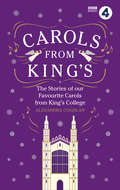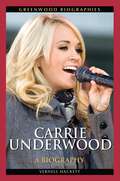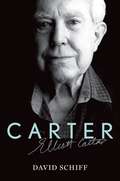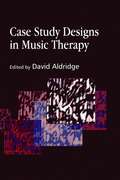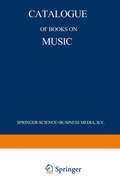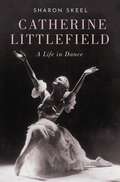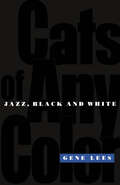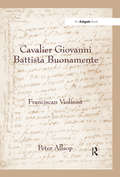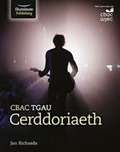- Table View
- List View
Carole King's Tapestry (33 1/3)
by Loren GlassCarole King's Tapestry is both an anthemic embodiment of second-wave feminism and an apotheosis of the Laurel Canyon singer-songwriter sound and scene. And these two elements of the album's historic significance are closely related insofar as the professional autonomy of the singer-songwriter is an expression of the freedom and independence women of King's generation sought as the turbulent sixties came to a close.Aligning King's own development from girl to woman with the larger shift in the music industry from teen-oriented singles by girl groups to albums by adult-oriented singer-songwriters, this volume situates Tapestry both within King's original vision as the third in a trilogy (preceded by Now That Everything's Been Said and Writer) and as a watershed in musical and cultural history, challenging the male dominance of the music and entertainment industries and laying the groundwork for female dominated genres such as women's music and Riot Grrrl punk.
Carole King's Tapestry (33 1/3 #153)
by Loren GlassCarole King's Tapestry is both an anthemic embodiment of second-wave feminism and an apotheosis of the Laurel Canyon singer-songwriter sound and scene. And these two elements of the album's historic significance are closely related insofar as the professional autonomy of the singer-songwriter is an expression of the freedom and independence women of King's generation sought as the turbulent sixties came to a close.Aligning King's own development from girl to woman with the larger shift in the music industry from teen-oriented singles by girl groups to albums by adult-oriented singer-songwriters, this volume situates Tapestry both within King's original vision as the third in a trilogy (preceded by Now That Everything's Been Said and Writer) and as a watershed in musical and cultural history, challenging the male dominance of the music and entertainment industries and laying the groundwork for female dominated genres such as women's music and Riot Grrrl punk.
Carols From King's
by Alexandra CoghlanThe exquisite sound of a lone chorister singing Once in Royal David’s City amid the candlelit chapel of King’s College, Cambridge, marks the start of the Christmas festivities for millions of people round the globe. Broadcast at 3pm on Christmas Eve, A Festival of Nine Lessons and Carols provides a precious moment of tranquillity amongst the bustle of the festive season. Take a journey through the fascinating history of carols, from the very first - sung by the angels to the shepherds at Bethlehem - to anecdotes from contemporary King's choristers. Learn how carols have evolved from pagan songs to become one of our nation's most sacred treasures. Accompanied by lyrics and music and compiled in conjunction with Radio 4 and King’s College Chapel, Carols From King’s is the official companion for fans of Christmas and carols alike.
Carrie Underwood: A Biography (Greenwood Biographies)
by Vernell HackettIn this book, follow the career of Carrie Underwood as she goes from the American Idol competition to worldwide celebrity.Carrie Underwood: A Biography follows the singer from a small town in Oklahoma to the stages of the most prestigious concert halls in the world. Along the way, fans will read about this girl-next-door's decision to compete on American Idol and her subsequent triumph there, about her first recordings in Nashville and her platinum albums, and about her sold-out concert tours with superstars like Brad Paisley, Kenny Chesney, and Keith Urban.But the book isn't only about Underwood as a celebrity. It is also about how she uses that celebrity to do good works, including speaking out for the Humane Society of the United States, participating in a song that benefited Stand Up For Cancer, doing public service announcements for the Do Something youth organization, and touring for the USO.
Carrie Underwood: A Biography (Greenwood Biographies)
by Vernell HackettIn this book, follow the career of Carrie Underwood as she goes from the American Idol competition to worldwide celebrity.Carrie Underwood: A Biography follows the singer from a small town in Oklahoma to the stages of the most prestigious concert halls in the world. Along the way, fans will read about this girl-next-door's decision to compete on American Idol and her subsequent triumph there, about her first recordings in Nashville and her platinum albums, and about her sold-out concert tours with superstars like Brad Paisley, Kenny Chesney, and Keith Urban.But the book isn't only about Underwood as a celebrity. It is also about how she uses that celebrity to do good works, including speaking out for the Humane Society of the United States, participating in a song that benefited Stand Up For Cancer, doing public service announcements for the Do Something youth organization, and touring for the USO.
Carter (Master Musicians Series)
by David SchiffElliott Carter (1908-2012) was the foremost composer of classical music in America during the second half of the 20th century. Over the course of a career that spanned seven decades, he consistently produced works that critics hailed as creatively daring, intellectually demanding, and emotionally complex. Distancing himself from the various "schools" and movements that grew and waned in popularity during the postwar era, Carter cultivated a deeply personal musical style that he developed and refined up until the very end of his life. This book of the composer springs from author David Schiff's life-long interest in Elliott Carter's music and his close personal connection with the composer which spanned over forty years. This critical overview of Carter's life and work explores aspects of the composer's life about which he was usually reticent--and occasionally misleading--such as his complicated relationships with Charles Ives, Aaron Copland, Nicolas Nabokov, and his own parents. Schiff's study of Carter's complete oeuvre--from his politically charged Depression-era ballets to the deeply personal and reflective late works--is based on extensive study of the composer's personal sketches and letters. Featuring an in-depth look at the legacy project of Carter's final decade, seven settings of American modernist poetry by E.E. Cummings, T.S. Eliot, Marianne Moore, Ezra Pound, Wallace Stevens and William Carlos Williams, this newest addition to the Master Musicians Series paints with a fine brush the story of America's foremost composer of the second half of the twentieth century.
Carter (Master Musicians Series)
by David SchiffElliott Carter (1908-2012) was the foremost composer of classical music in America during the second half of the 20th century. Over the course of a career that spanned seven decades, he consistently produced works that critics hailed as creatively daring, intellectually demanding, and emotionally complex. Distancing himself from the various "schools" and movements that grew and waned in popularity during the postwar era, Carter cultivated a deeply personal musical style that he developed and refined up until the very end of his life. This book of the composer springs from author David Schiff's life-long interest in Elliott Carter's music and his close personal connection with the composer which spanned over forty years. This critical overview of Carter's life and work explores aspects of the composer's life about which he was usually reticent--and occasionally misleading--such as his complicated relationships with Charles Ives, Aaron Copland, Nicolas Nabokov, and his own parents. Schiff's study of Carter's complete oeuvre--from his politically charged Depression-era ballets to the deeply personal and reflective late works--is based on extensive study of the composer's personal sketches and letters. Featuring an in-depth look at the legacy project of Carter's final decade, seven settings of American modernist poetry by E.E. Cummings, T.S. Eliot, Marianne Moore, Ezra Pound, Wallace Stevens and William Carlos Williams, this newest addition to the Master Musicians Series paints with a fine brush the story of America's foremost composer of the second half of the twentieth century.
Caruso and Tetrazzini On the Art of Singing
by Luisa Tetrazzini Enrico CarusoTwo of opera's greatest names offer encouragement and useful advice to aspiring singers in this classic guide. Tenor Enrico Caruso and coloratura soprano Luisa Tetrazzini employ nontechnical terms to provide an informal vocalist's anatomy, with instructions for the proper training, care, and disposition of the tongue, lungs, diaphragm, mouth, and the voice itself.Tetrazzini deals with the foundations of singing in breath control; tone emission and attack; and, sending aspiring performers to the mirror, facial expression and dress. Caruso remarks on tone production; such faults as the "white voice" and "goat voice"; the necessity of good diction; the role of diet; and the part superstition plays in certain singers' performances. These consummate artists show great charm and presence as writers, and this little book is a great pleasure to read.
The Case of the Sexy Jewess: Dance, Gender and Jewish Joke-work in US Pop Culture
by Hannah SchwadronAmidst the growing forums of kinky Jews, orthodox drag queens, and Jewish geisha girls, we find today's sexy Jewess in a host of reflexive plays with sexed-up self-display. A social phantasm with real legs, she moves boldly between neo-burlesque striptease, comedy television, ballet movies, and progressive porn to construct the 21st Century Jewish American woman through charisma and comic craft, in-your-face antics, and offensive charm. Her image redresses longstanding stereotypes of the hag, the Jewish mother, and Jewish American princess that have demeaned the Jewish woman as overly demanding, inappropriate, and unattractive across the 20th century, even as Jews assimilated into the American mainstream. But why does "sexy" work to update tropes of the Jewish woman? And how does sex link to humor in order for this update to work? Entangling questions of sexiness to race, gender, and class, The Case of the Sexy Jewess frames an embodied joke-work genre that is most often, but not always meant to be funny. In a contemporary period after the thrusts of assimilation and women's liberation movements, performances usher in new versions of old scripts with ranging consequences. At the core is the recuperative performance of identity through impersonation, and the question of its radical or conservative potential. Appropriating, re-appropriating, and mis-appropriating identity material within and beyond their midst, Sexy Jewess artists play up the failed logic of representation by mocking identity categories altogether. They act as comic chameleons, morphing between margin and center in countless number of charged caricatures. Embodying ethnic and gender positions as always already on the edge while ever more in the middle, contemporary Jewish female performers extend a comic tradition in new contexts, mobilizing progressive discourses from positions of newfound race and gender privilege.
CASE OF THE SEXY JEWESS C: Dance, Gender and Jewish Joke-work in US Pop Culture
by Hannah SchwadronAmidst the growing forums of kinky Jews, orthodox drag queens, and Jewish geisha girls, we find today's sexy Jewess in a host of reflexive plays with sexed-up self-display. A social phantasm with real legs, she moves boldly between neo-burlesque striptease, comedy television, ballet movies, and progressive porn to construct the 21st Century Jewish American woman through charisma and comic craft, in-your-face antics, and offensive charm. Her image redresses longstanding stereotypes of the hag, the Jewish mother, and Jewish American princess that have demeaned the Jewish woman as overly demanding, inappropriate, and unattractive across the 20th century, even as Jews assimilated into the American mainstream. But why does "sexy" work to update tropes of the Jewish woman? And how does sex link to humor in order for this update to work? Entangling questions of sexiness to race, gender, and class, The Case of the Sexy Jewess frames an embodied joke-work genre that is most often, but not always meant to be funny. In a contemporary period after the thrusts of assimilation and women's liberation movements, performances usher in new versions of old scripts with ranging consequences. At the core is the recuperative performance of identity through impersonation, and the question of its radical or conservative potential. Appropriating, re-appropriating, and mis-appropriating identity material within and beyond their midst, Sexy Jewess artists play up the failed logic of representation by mocking identity categories altogether. They act as comic chameleons, morphing between margin and center in countless number of charged caricatures. Embodying ethnic and gender positions as always already on the edge while ever more in the middle, contemporary Jewish female performers extend a comic tradition in new contexts, mobilizing progressive discourses from positions of newfound race and gender privilege.
Case Study Designs in Music Therapy
by Denise Grocke Cochavit Elefant David Aldridge Hanne Mette Ridder Ochsner Gudrun AldridgeResearch and clinical work are often perceived as opposites in the field of music therapy. This book shows, for the first time, how these two areas of work can creatively complement one another, proving beneficial to both disciplines. Each chapter is written by a leading researcher and practitioner in the field, and the book covers a wide spectrum of approaches within different settings. Beginning with methodological and musicological approaches to case studies, the book then moves on to more specific topics such as the use of case studies in an interactive play setting and in music therapy with the elderly. Later chapters explore theoretical aspects, looking at a worked example of music and progressive change during therapy, and how case study designs can be used in practice. A must for all professionals working and studying within the music therapy area, this is also an informative and useful book for health researchers.
Case Study Designs in Music Therapy (PDF)
by Cochavit Elefant David Aldridge Denise Grocke Gudrun Aldridge Hanne Mette Ridder Ochsner Tony WigramResearch and clinical work are often perceived as opposites in the field of music therapy. This book shows, for the first time, how these two areas of work can creatively complement one another, proving beneficial to both disciplines. Each chapter is written by a leading researcher and practitioner in the field, and the book covers a wide spectrum of approaches within different settings. Beginning with methodological and musicological approaches to case studies, the book then moves on to more specific topics such as the use of case studies in an interactive play setting and in music therapy with the elderly. Later chapters explore theoretical aspects, looking at a worked example of music and progressive change during therapy, and how case study designs can be used in practice. A must for all professionals working and studying within the music therapy area, this is also an informative and useful book for health researchers.
Cast a Diva: The Hidden Life of Maria Callas
by Lyndsy SpenceCall it ‘charm’, call it ‘magic’, call it ‘Maria’ - Dorle Soria ‘The new face of Maria Callas … is even more dramatic than how History (with a capital H) has already painted it.’ - Vogue Italia Maria Callas (1923–77) was the greatest opera diva of all time. Despite a career that remains unmatched by any prima donna, much of her life was overshadowed by her fiery relationship with Aristotle Onassis, who broke her heart when he left her for Jacqueline Kennedy, and her legendary tantrums on and off the stage. However, little is known about the woman behind the diva. She was a girl brought up between New York and Greece, who was forced to sing by her emotionally abusive mother and who left her family behind in Greece for an international career. Feted by royalty and Hollywood stars, she fought sexism to rise to the top, but there was one thing she wanted but could not have – a happy private life. In Cast a Diva, bestselling author Lyndsy Spence draws on previously unseen documents to reveal the raw, tragic story of a true icon.
Cat Power's Moon Pix: (pdf) (33 1/3)
by Donna KozloskieMoon Pix was conceived during a hallucinatory waking nightmare in the South Carolina home of Chan Marshall one fateful day in 1997. Spirits violently swam up around her house, looming at the windows, beckoning her to join them. Her and her acoustic guitar warded them off song after song, nearly the entire album rushed forth onto a tape recorder that night. Facts, fictions and visions ripple throughout the accounts of Moon Pix from every angle- memories of screaming at an audience, spirals of drunkenness, swimming with sharks in Australia, intense, resonant lyrics and thunderstorms ringing through speakers. Like all legends, the aura surrounding them is an impression, a sensory feeling of unreliable memories: layers of stories become histories. Through interviews with key players, audience member accounts, fictional narrative imaginings, a collection of record reviews and other explorations of truth, this book, like Moon Pix itself, is an ode to the myth within the music and the music within the myth.
Cat Power's Moon Pix (33 1/3)
by Donna KozloskieMoon Pix was conceived during a hallucinatory waking nightmare in the South Carolina home of Chan Marshall one fateful day in 1997. Spirits violently swam up around her house, looming at the windows, beckoning her to join them. Her and her acoustic guitar warded them off song after song, nearly the entire album rushed forth onto a tape recorder that night. Facts, fictions and visions ripple throughout the accounts of Moon Pix from every angle- memories of screaming at an audience, spirals of drunkenness, swimming with sharks in Australia, intense, resonant lyrics and thunderstorms ringing through speakers. Like all legends, the aura surrounding them is an impression, a sensory feeling of unreliable memories: layers of stories become histories. Through interviews with key players, audience member accounts, fictional narrative imaginings, a collection of record reviews and other explorations of truth, this book, like Moon Pix itself, is an ode to the myth within the music and the music within the myth.
Catherine Littlefield: A Life in Dance
by Sharon SkeelWhile she is best remembered today as founder of the Philadelphia Ballet and the director and driving force behind the famous Littlefield School of Ballet, from which Balanchine drew the nucleus for his School of American Ballet, Catherine Littlefield (1905-51) and her oeuvre were in many ways emblematic of the full representation of dance throughout entertainments of the first half of the 20th century. From her early work as a teenager dancing for Florenz Ziegfeld to her later work in choreographing extravagant ice skating shows, a remarkable dance with 90 bicyclists for the 1940 World's Fair, and on television as resident choreographer for The Jimmy Durante Show, Littlefield was amongst the first choreographers to bring concert dance to broader venues, and her legacy lives on today in her enduring influence on generations of American ballet dancers. As the first biography of Littlefield, Catherine Littlefield: A Life in Dance traces her life in full from birth through childhood experiences dancing on the Academy of Music's grand stage, and from her foundation of the groundbreaking Philadelphia Ballet Company in 1935 to her later work in television and beyond. Littlefield counted among her many glamorous friends and colleagues writer Zelda Fitzgerald, conductor Leopold Stokowski, and composer Kurt Weill. This biography also provides an engrossing portrait of the remarkable Littlefield family, many of whom were instrumental to Catherine's success. With the unflagging support of her generous husband and indomitable mother, Littlefield gave shape to the course of American ballet in the 20th century long before Balanchine arrived in the United States.
Catherine Littlefield: A Life in Dance
by Sharon SkeelWhile she is best remembered today as founder of the Philadelphia Ballet and the director and driving force behind the famous Littlefield School of Ballet, from which Balanchine drew the nucleus for his School of American Ballet, Catherine Littlefield (1905-51) and her oeuvre were in many ways emblematic of the full representation of dance throughout entertainments of the first half of the 20th century. From her early work as a teenager dancing for Florenz Ziegfeld to her later work in choreographing extravagant ice skating shows, a remarkable dance with 90 bicyclists for the 1940 World's Fair, and on television as resident choreographer for The Jimmy Durante Show, Littlefield was amongst the first choreographers to bring concert dance to broader venues, and her legacy lives on today in her enduring influence on generations of American ballet dancers. As the first biography of Littlefield, Catherine Littlefield: A Life in Dance traces her life in full from birth through childhood experiences dancing on the Academy of Music's grand stage, and from her foundation of the groundbreaking Philadelphia Ballet Company in 1935 to her later work in television and beyond. Littlefield counted among her many glamorous friends and colleagues writer Zelda Fitzgerald, conductor Leopold Stokowski, and composer Kurt Weill. This biography also provides an engrossing portrait of the remarkable Littlefield family, many of whom were instrumental to Catherine's success. With the unflagging support of her generous husband and indomitable mother, Littlefield gave shape to the course of American ballet in the 20th century long before Balanchine arrived in the United States.
Cathy Berberian: Pioneer Of Contemporary Vocality
by Pamela Karantonis Francesca Placanica Pieter VerstraeteCathy Berberian (1925-1983) was a vocal performance artist, singer and composer who pioneered a way of composing with the voice in the musical worlds of Europe, North America and beyond. As a modernist muse for many avant-garde composers, Cathy Berberian went on to embody the principles of postmodern thinking in her work, through vocality. She re-defined the limits of composition and challenged theories of the authorship of the musical score. This volume celebrates her unorthodox path through musical landscapes, including her approach to performance practice, gender performativity, vocal pedagogy and the culturally-determined borders of art music, the concert stage, the popular LP and the opera industry of her times. The collection features primary documentation-some published in English for the first time-of Berberian’s engagement with the philosophy of voice, new music, early music, pop, jazz, vocal experimentation and technology that has come to influence the next generation of singers such as Theo Bleckmann, Susan Botti, Joan La Barbara, Rinde Eckert Meredith Monk, Carol Plantamura, Candace Smith and Pamela Z. Hence, this timely anthology marks an end to the long period of silence about Cathy Berberian’s championing of a radical rethinking of the musical past through a reclaiming of the voice as a multifaceted phenomenon. With a Foreword by Susan McClary.
Cathy Berberian: Pioneer of Contemporary Vocality
by Pamela Karantonis Francesca Placanica Pieter VerstraeteCathy Berberian (1925-1983) was a vocal performance artist, singer and composer who pioneered a way of composing with the voice in the musical worlds of Europe, North America and beyond. As a modernist muse for many avant-garde composers, Cathy Berberian went on to embody the principles of postmodern thinking in her work, through vocality. She re-defined the limits of composition and challenged theories of the authorship of the musical score. This volume celebrates her unorthodox path through musical landscapes, including her approach to performance practice, gender performativity, vocal pedagogy and the culturally-determined borders of art music, the concert stage, the popular LP and the opera industry of her times. The collection features primary documentation-some published in English for the first time-of Berberian’s engagement with the philosophy of voice, new music, early music, pop, jazz, vocal experimentation and technology that has come to influence the next generation of singers such as Theo Bleckmann, Susan Botti, Joan La Barbara, Rinde Eckert Meredith Monk, Carol Plantamura, Candace Smith and Pamela Z. Hence, this timely anthology marks an end to the long period of silence about Cathy Berberian’s championing of a radical rethinking of the musical past through a reclaiming of the voice as a multifaceted phenomenon. With a Foreword by Susan McClary.
Cats of Any Color: Jazz Black and White
by Gene LeesIt was none other than Louis Armstrong who said, "These people who make the restrictions, they don't know nothing about music. It's no crime for cats of any color to get together and blow." "You can't know what it means to be black in the United States--in any field," Dizzy Gillespie once said, but Gillespie vigorously objected to the proposition that only black people could play jazz. "If you accept that premise, well then what you're saying is that maybe black people can only play jazz. And black people, like anyone else, can be anything they want to be." In Cats of Any Color, Gene Lees, the acclaimed author of three previous collections of essays on jazz and popular music, takes a long overdue look at the shocking pervasiveness of racism in jazz's past and present--both the white racism that long ghettoized the music and generations of talented black musicians, and what Lees maintains is an increasingly virulent reverse racism aimed at white jazz musicians. In candid interviews, living jazz legends, critics, and composers step forward and share their thoughts on how racism has affected their lives. Dave Brubeck, part Modoc Indian, discusses native Americans' contribution to jazz and the deeply ingrained racism that for a time made it all but impossible for jazz groups with black and white players to book tours and television appearances. Horace Silver looks back on his long career, including the first time he ever heard jazz played live. Blacks were not not allowed into the pavilion in Connecticut where Jimmie Lunceford's band was performing, so the ten-year-old Silver listened and watched through the wooden slats surrounding the pavilion. "And oh man! That was it!" Silver recalls. Red Rodney recalls his early days with Charlie "Bird" Parker, and pianist and composer Cedar Walton tells of the time Duke Ellington played at the army base at Ford Dix and allowed the young enlisted Walton to sit in. Tracing the jazz world's shifting attitude towards race, many of the stories Lees tells are inspiring--Brubeck cancelling 23 out of 25 concert dates in the South rather than replace black bass player Eugene Wright, or Silver insisting that while he strives to provide his fellow black musicians opportunities, "I just want the best musicans I can get. I don't give a damn if they're pink or polka dot." Others are profoundly disturbing--Lees' first encounter with Oscar Peterson, after a Canadian barber flatly refused to cut Peterson's hair, or Wynton Marsalis on television claiming that blacks have been held back for so many years because the music business is controlled by "people who read the Torah and stuff." From the old shantytowns of Louisville, to the streets of South Central L.A., to the up-to-the-minute controversies surrounding Marsalis's jazz program at Lincoln Center, and the Jazz Masters awards given by the NEA, Cats of Any Color confronts racism head-on. At its heart is a passionate plea to recognize jazz not as the sole property of any one group, but as an art form celebrating the human spirit--not just for the protection of individual musicians, but for the preservation of the music itself.
Cavalier Giovanni Battista Buonamente: Franciscan Violinist
by Peter AllsopGiovanni Battista Buonamente was among the most original and inventive Italian composers of the seventeenth century. Peter Allsop reveals his importance as part of a tradition that stands in direct antithesis to that of the Corellian sonata today regarded as the 'norm'. This development is traced in a series of likely teacher-pupil relationships from Salamone Rossi to Marco Uccellini, the most prolific Italian composers of instrumental ensemble music in the first half of the seventeenth century. The first half of the book sets out what is known of Buonamente's turbulent career as he moved from the courtly environments of the Gonzaga household and Habsburg court to several less auspicious posts at various religious institutions, ending his life as maestro di cappella at the mother house of his order, S. Francesco in Assisi. A fascinating picture emerges of the nature of musical patronage against a background of war and plague in this time of great political instability. The later chapters comprise detailed discussions, supported with over 100 music examples, of the unusually wide range of genres for which Buonamente wrote: sinfonias, free sonatas, sets of variations, canzonas, dances; and he was the first Italian to cultivate the ensemble suite to any extent. The book concludes with an examination of his influence on his probable pupil Marco Uccellini and the interest Buonamente instigated in canonic writing, which was passed via Uccellini to a succession of Modenese composers.
Cavalier Giovanni Battista Buonamente: Franciscan Violinist
by Peter AllsopGiovanni Battista Buonamente was among the most original and inventive Italian composers of the seventeenth century. Peter Allsop reveals his importance as part of a tradition that stands in direct antithesis to that of the Corellian sonata today regarded as the 'norm'. This development is traced in a series of likely teacher-pupil relationships from Salamone Rossi to Marco Uccellini, the most prolific Italian composers of instrumental ensemble music in the first half of the seventeenth century. The first half of the book sets out what is known of Buonamente's turbulent career as he moved from the courtly environments of the Gonzaga household and Habsburg court to several less auspicious posts at various religious institutions, ending his life as maestro di cappella at the mother house of his order, S. Francesco in Assisi. A fascinating picture emerges of the nature of musical patronage against a background of war and plague in this time of great political instability. The later chapters comprise detailed discussions, supported with over 100 music examples, of the unusually wide range of genres for which Buonamente wrote: sinfonias, free sonatas, sets of variations, canzonas, dances; and he was the first Italian to cultivate the ensemble suite to any extent. The book concludes with an examination of his influence on his probable pupil Marco Uccellini and the interest Buonamente instigated in canonic writing, which was passed via Uccellini to a succession of Modenese composers.
CBAC TGAU Cerddoriaeth
by Jan RichardsYsgrifennwyd y gwerslyfr cynhwysfawr hwn gan yr arholwr profiadol Jan Richards. Mae’n ganllaw hynod o ymarferol sy’n rhoi cefnogaeth, cyngor ac arweiniad ar gyfer pob rhan o’r cymhwyster TGAU Cerddoriaeth. Bydd arddull weledol liwgar a hygyrch y gyfrol, a’r cyfoeth o gyngor gwerthfawr, yn eich cynnal yn ystod y cwrs TGAU, ac yn eich helpu i baratoi at eich asesiad perfformio a’ch asesiad cyfansoddi di-arholiad. *Datganiad hawlfraint Gwneir y copi hwn dan dermau Rheoliadau (Anabledd) Hawlfraint a Hawliau mewn Perfformiadau 2014 i'w ddefnyddio gan berson sy'n anabl o ran print yn unig. Oni chaniateir gan gyfraith, ni ellir ei gopïo ymhellach, na'i roi i unrhyw berson arall, heb ganiatâd.


